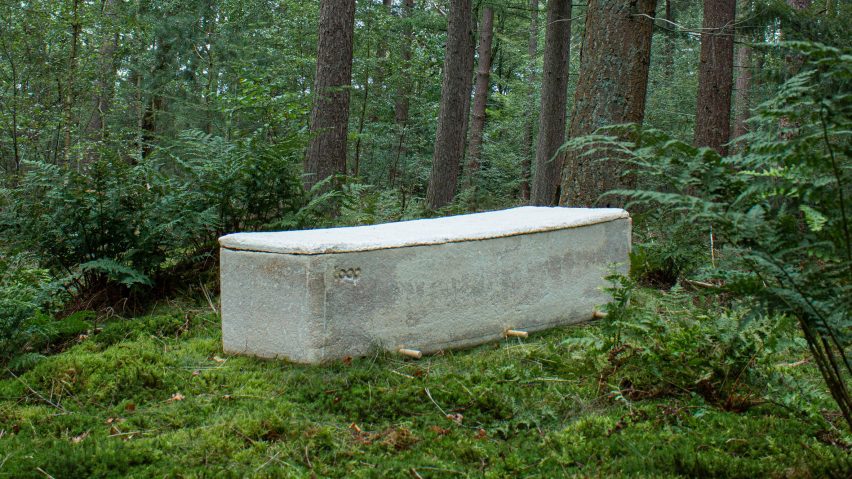TU Delft researcher Bob Hendrikx has created Living Cocoon, a coffin made from mycelium that helps bodies decompose faster while improving the surrounding soil.
Made from mushroom mycelium, the Living Cocoon actively contributes to the body's composting process after death and simultaneously removes toxic substances from the earth – creating richer conditions for new plants to grow.
The boxy coffin takes one week to grow and then, containing the body of the deceased, takes an estimated two to three years to decompose. In comparison, conventional coffin burials take over ten years to break down in the earth.
Hendrikx, who is a researcher at the Delft University of Technology, hopes what he calls a "living coffin" can create a closed-loop system for disposing of the dead and repairing some of the damage done by humans to the earth.
"We are currently living in nature's graveyard," he said. "Our behaviour is not only parasitic, it's also short-sighted. We are degrading organisms into dead, polluting materials, but what if we kept them alive?"
"The Living Cocoon enables people to become one with nature again, and to enrich the soil instead of polluting it."
Described by Hendrikx as "nature's recycler", mycelium is the thread-like part of a fungus that typically grows underground. Its function is to feed the fungus by secreting enzymes to break down biological polymers, aiding decomposition and releasing carbon dioxide back into the atmosphere.
"Mycelium is constantly looking for waste materials to convert into nutrients for the environment," the designer continued. "It does the same with toxic substances, including oil, plastic and metal."
"For example, mycelium was used in Chernobyl, it is utilised in Rotterdam to clean up soil, and some farmers also apply it to make the land healthy again."
As Hendrikx told Dezeen, he first came up with the idea to use the fungus to make a coffin during last year's Dutch Design Week, where he presented his living home – inhabitable pods made from mycelium.
"A girl walked up to me and asked 'What if my grandma dies? Can I just leave her there?'," he explained.
"And that's when I realised what mycelium could do for us humans, bringing us back into the cycle of life and allowing us to provide food for plants."
Each Living Cocoon is grown and formed in seven days. To make the coffins, Hendrikx and his team mix their preferred type of mycelium with an organic substrate in a mould.
The mycelium eats this substrate, creating a three-dimensional structure that grows to fill the shape of the mould it is in.
As the designer explained, the entire production process is passive, meaning it doesn't require any energy, heat or light.
Developed under Hendrikx's startup based in the Netherlands called Loop, the Living Cocoons have been tested with the help of funeral cooperatives CUVO, based in The Hague, and De Laatste Eer, based in Delft.
The startup has begun testing its first batch of ten mycelium coffins last week when they were used for a funeral.
Further tests have also been conducted by New York-based biotech company Ecovative, and have shown that the coffin itself is absorbed into the earth within 30 to 45 days, under normal Dutch soil conditions.
The team is yet to fully test the effects of the coffin on soil quality in increasing biodiversity.
"We want to know exactly what contribution it makes to the soil as this will help us to convince local municipalities in the future to transform polluted areas into healthy woodland, using our bodies as nutrients," said Hendrikx.
Hendrikx and his team are currently working with light-emitting fungi to find a way of making them grow from the coffin through the soil and up above the earth as a marker of where the body is buried.
This way, illuminating mushrooms can be used in place of the flowers or lights that people typically place on the grave.
Hendrikx one of several designers aiming to make death more sustainable. Anna Citelli and Raoul Bretzel created a biodegradable egg-shaped pod for the deceased that is buried in the earth before a tree is planted above.
Shaina Garfield also designed an eco-friendly coffin that, similarly to the Living Cocoon, uses fungus to biodegrade the body at a faster rate while fertilising the surrounding soil.

